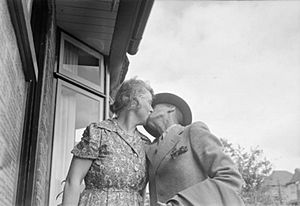Demobilisation of the British Armed Forces after the Second World War facts for kids

After World War II ended, about five million people were serving in the British Armed Forces. Getting all these soldiers, sailors, and air force members back to their normal lives was a huge challenge. The British government, led by the Labour Party, had to figure out how to do this smoothly. This process of sending military members home is called demobilisation.
Contents
Demobilisation Plan: Sending Soldiers Home
The main person behind the plan to send soldiers home was Ernest Bevin. He was a very important government minister at the time. People really wanted peace after the war, so the government worked quickly on this plan. Also, Britain needed workers to help rebuild the country after the war. This plan had support from both major political parties, which was unusual for the time.
The government shared the details of the plan on September 22, 1944. It was set to start on June 18, 1945. Soldiers knew all about the process, including how they would be supported after leaving the military. Most people were released based on their 'age-and-service number'. This number was calculated using their age and how long they had served. Some people with special skills needed for rebuilding the country were sent home earlier. Also, married women and men over 50 years old got priority.
Military personnel went through special places called demobilisation centres to complete the process.
The Release Process: What Happened Next?
The process of sending people home started on time, about six weeks after V-E Day. Soldiers who were leaving the military received some money and a new set of civilian clothes. This often included a special suit, known as the "demob suit", along with shirts, underwear, a raincoat, a hat, and shoes.
By the end of 1945, about 750,000 soldiers had been sent home. This number doubled just two months later, after Japan surrendered. By 1947, around 4.3 million men and women were back in 'civvy street', which means civilian life.
The process wasn't always easy. Some soldiers felt it was too slow. This led to some problems and protests in the military during the winter of 1945-46. The most famous were the RAF 'strikes' in India and South East Asia. Because of these frustrations, some parts of the plan were changed or stopped.
Personal Challenges: Life After War
Besides the official process, returning soldiers faced many personal challenges. Britain had been bombed and blockaded for six years. There were shortages of many basic things like food, clothing, and housing.
Husbands and wives also had to get used to living together again after being apart for many years. This was sometimes difficult. One way we can see these social problems is by looking at the number of divorces after the war. In 1947 alone, over 60,000 divorce applications were made. This number wasn't reached again until the 1960s.
Demobilisation Centres: Where They Went Home
When British servicemen and women finished their time in the military after World War II, they went through a demobilisation centre. If they were returning from another country, they first went to a "disembarkation unit." After that, they moved to a "dispersal unit" to complete their release. These centres helped them transition back to civilian life.
See also
- Civil Resettlement Units
- Demobilization
- Demobilisation of the Australian military after World War II
- Demobilization of United States armed forces after World War II
- Demob suit
- Military discharge
- Military history of the United Kingdom during World War II
- National Service (Armed Forces) Act 1939
- Royal Air Force Mutiny of 1946
- Post–World War II demobilization strikes

